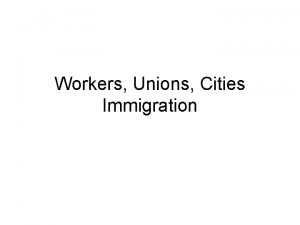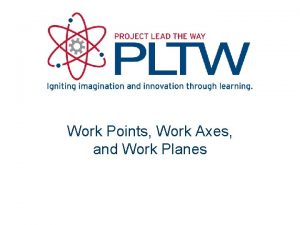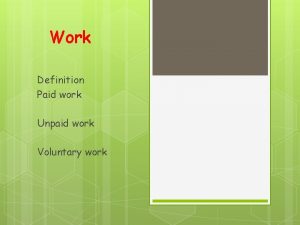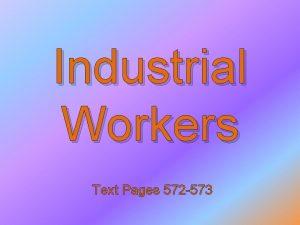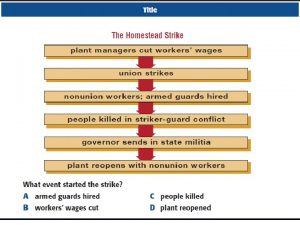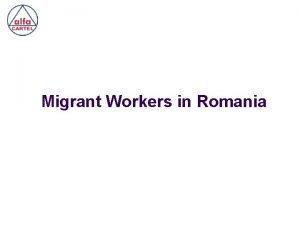The Industrial Workers Industrial Workers Industrial work was















- Slides: 15

The Industrial Workers

Industrial Workers • Industrial work was hard: – Laborers worked long hours & received low wages but had expensive living costs – Industrial work was unskilled, dangerous, & monotonous – Gender, religious, & racial biases led to different pay scales • These conditions led to a small, but significant union movement

Early American Labor Unions • In 1868, Knights of Labor formed to help all type of workers escape the “wage system” regardless of skill, race, or sex Membership • The most successful union, the American The Ko. L lacked organization to survive Excluded women, blacks, unskilled Federation of Labor (1886) led bylaborers Samuel Gompers: – Made up only of skilled labor & sought practical objectives (better pay, hours, conditions) – Included 1/3 of all U. S. laborers

The U. S. experienced an “era of strikes” from 1870 -1890 The Great RR Strike of 1877 During The Homestead the Chicago Strike Haymarket (1892) Strike (1886), from shut downresulted railroads froma 20% unionists pay cut demanded at one of. WV an. Carnegie’s 8 -hr day; led toplants mob to CA &steel resulted in violence & the death ofhundreds the Knights of Labor of deaths

• Essential Question: Question – How did the industrialization of the Gilded Age transform cities & immigration in America? • Reading Quiz Ch 19 A (648— 663)

Urbanization: 1870 -1900

Gilded Age Urbanization • From 1870 to 1900, American cities grew 700% due to new job opportunities in factories: – European, Latin American, & Asian immigrants flooded cities – Blacks migrated into the North – Rural farmers moved from the countryside to cities

The Lure of the City By 1920, for the 1 st time in U. S. history, more than 50% of the American population lived in cities

Skyscrapers and Suburbs • By the 1880 s, steel allowed cities to build skyscrapers • The Chicago fire of 1871 allowed for rebuilding with new designs: – John Root & Louis Sullivan were the “fathers of modern urban architecture” – New York & other cities used Chicago as their model

Louis Sullivan “Form follows John Root “Simple & Dignified” function”

Western Union Building, NYC Grand Central Station in NYC Wadsworth Building, NYC

Skyscrapers and Suburbs • Cities developed distinct zones: – Central business district with working- & upperclass residents – Middle-class in the suburbs • Electric streetcars & elevated rapid transit made travel easy

Tenements & Overcrowding • ½ of NYC’s buildings were tenements which housed the poor working class – “Dumbbell” tenements were popular but were cramped & plagued by firetraps – Slums had poor sanitation, polluted water & air, tuberculosis – Homicide, suicide, & alcoholism rates all increased in U. S. cities

Jacob Riis’ “How the Other Half Lives” (1890) exposed the poverty of the urban poor

Strangers in a New Land • From 1880 -1920, 23 million immigrants came looking for jobs: – These “new” immigrants were from eastern & southern Europe; Catholics & Jews, not Protestant – Kept their language & religion; created ethnic newspapers, schools, & social associations – Led to a resurgence in Nativism & attempts to limit immigration
 Hát kết hợp bộ gõ cơ thể
Hát kết hợp bộ gõ cơ thể Ng-html
Ng-html Bổ thể
Bổ thể Tỉ lệ cơ thể trẻ em
Tỉ lệ cơ thể trẻ em Voi kéo gỗ như thế nào
Voi kéo gỗ như thế nào Glasgow thang điểm
Glasgow thang điểm Chúa sống lại
Chúa sống lại Môn thể thao bắt đầu bằng chữ đua
Môn thể thao bắt đầu bằng chữ đua Thế nào là hệ số cao nhất
Thế nào là hệ số cao nhất Các châu lục và đại dương trên thế giới
Các châu lục và đại dương trên thế giới Công thức tiính động năng
Công thức tiính động năng Trời xanh đây là của chúng ta thể thơ
Trời xanh đây là của chúng ta thể thơ Mật thư tọa độ 5x5
Mật thư tọa độ 5x5 Làm thế nào để 102-1=99
Làm thế nào để 102-1=99 Phản ứng thế ankan
Phản ứng thế ankan Các châu lục và đại dương trên thế giới
Các châu lục và đại dương trên thế giới

















